ARDUINO PRO AND PRO MINI
– August 23rd, 2008

We’re very pleased to announce the launch of the Arduino Pro and Arduino Pro Mini, designed and manufactured by SparkFun Electronics (see their announcement). They are low-cost, low-profile boards intended for advanced users and for convenient embedding in long-term projects. Both work with an off-board USB convertor (either the FTDI TTL-232R-3V3 USB or the SparkFunFTDI Basic Breakout. The boards come without headers, allowing users to select and attach the ones appropriate for their use. If you solder on female headers, you can use standard shields with the Pro. Unlike other Arduino boards, these work at 3.3V, so be careful when attaching external components.
Both boards are available for purchase from SparkFun, the Pro for $20 and thePro Mini for $19. It’s been great to continue working with SparkFun, who also design and produce the LilyPad Arduino with Leah Buechley. The LilyPad has been a great success, and we hope the Pro and Pro Mini will be too.
BTW, if you’ve got an idea for a new Arduino product, please see this documentand email us at team@arduino.cc. We’re always looking for new collaborations.
CENDITEL, THE FOUNDATION ON OPEN TECHNOLOGIES
– August 16th, 2008
This summer has for sure been a complicated one. In the beginning of it, I introduced Arduino at Cenditel’s Open Technology Week (II Jornadas de Reflexión, Investigación y Desarrollo de Tecnologías Libres) that happened in Merida, Venezuela. Cenditel, which stands for Centro Nacional de Desarrollo e Investigación en Tecnologías Libres, is a foundation dedicated to supporting the introduction of open software and hardware tools into everyday life. Their plans go from the implementation of programs to handle collaborative project solving to the creation of an open source hardware factory to improve education and the creation of new types of business models within the country.
Football Bar in Merida, specialists in breakfasts and football camps
The event was not closed to technologists, it was free entrance, free knowledge, free coffee, free Arduino workshop, and free final dinner. People came from all over Venezuela and explained about different social projects carried by the foundation. On top of those, Cenditel’s researchers introduced us to their plans in manufacturing their own processors, developing intelligent card readers, or deploying water system controls for farmers.
I was guided through the city of Merida by the members of Cenditel’s open hardware team (or Hardware Libre, as they call themselves). I couldn’t resist the temptation of posting that picture of the Football bar where I was carried to one morning for breakfast.
During my stay in Merida I had no time for a break, I spoke about Arduino, later about business models and their relationship to intellectual property rights, ran a workshop for researchers on open hardware, participated in a series of round tables about open source hardware on which should be Venezuela’s strategy in the field considering their special location as an entrance to Latinamerica, and got first hand descriptions to several projects that will benefit of using Arduino as a prototyping technology.


Pictures by Ing. Carlos Soto, from the Cenditel Foundation
It was an intense week (you can read this article about the visit … my first answer to the journalist was “I am very tired”) but it was worth every minute. Venezuela is for sure an interesting country with a strong potential, andCenditel has the chance to make a move towards the deployment of new educational and economical models based on open source technologies.
LAST WEEK IN LONDON
– July 9th, 2008
David Sjunnesson reports from London about a show where he found “[...] two projects made with Arduino. The first one is controlling electromagnets to play a symphony depending on how people pass by and the second one is using a Lilypad controlling the angle of the the disc to always be rotated against the sun [...]“
Flying planter (Fledge) by Mike Hammock and Andy Usher, picture by D. Sjunnesson
It was The Bartlett School of Architecture show titled “Experiments in time” from the Dip unit 14. And the two pieces were called Urban Syncopation, a music instrument, and Flying planter (Fledge) an Arduino Lilypad controlled artifact that would rotate towards the sun.
Urban Syncopation by Tetsuro Nagata, picture by D. Sjunnesson
POORMAN´S OSCILLOSCOPE
– July 3rd, 2008
During my last workshop at iMAL (actually it was also the first one) I was lucky to meet a lot of interesting people. We were making music instruments out of Arduino … but his post is not about how much fun we had playing electronic instruments on the streets of Brussels 

performing in Brussels, copyright (c) 2008 by Accrochages
Among others I found a couple of young Quebec artists (on the next picture). Skilled as they are with electronics and AVR coding, they spend quite a lot of time crafting the electronics to shape their needs within the field of installation art and public interventions. Sofian Audry and Samuel St-Aubin have been artists in residence at iMAL for one month; during that period they have created several interesting pieces.
picture CC 3.0 SA by Cuartielles
They also produce small tools that can benefit many of us during our work. The one giving the title to this post, the poorman´s oscilloscope is one of my favorites. It is a combo putting together a Processing sketch and an Arduino program to plot the values from an analog port to the screen. Simple and pretty.

poorman´s oscilloscope, copyright (c) 2008 by Accrochages
On the other hand, during the workshop, they also produced “Glade [...] a free software audio library for Arduino (for use with Atmega8 and Atmega168 chips). The library provides basic functions for 8-bit audio playback using PWM, together with a digital audio processing library inspired from softwares such as PureData and ChucK“. Personally I love the idea of using 8-bit sound filters on top of my own stereo sound sequencer.
RESEARCH PROJECTS WITH ARDUINO?
– July 1st, 2008
The question keeps popping up: is Arduino used by non-artists and non-geeks? Is Arduino used in e.g. engineering education programs? Or … is Arduino part of a research project?
The fact is that there are many projects out there that use Arduino and related initiatives as quick prototyping tools. Already during 2006, in the early stages of the project, the Casteldefels campus from the Catalunya Polytechnics reported being using Arduino as part of a PhD course in engineering. Dan Steingart post-doc at Berkeley has been using it as a substitute to much more expensive gear, and created Ardustat together with a whole series of software tools dividing the cost of a pretty good galvanometer by a factor 10. We get reports from people using it in very many different fields from medicine to fashion design, including the very relevant open source fabrication of physical goods by the RepRap project.
image copyright (c) 2007 by Dan Steingart
Dan Steingart, happens to be co-owner of WIT, a wireless sensor company aiming the industrial market. Seems that his love for open source laboratories is shared by that other company -Libelium- that has just launched sensor-networks.org. In one of their posts they explain in depth in a series of videos how to construct you own Squidbee platform out of an Arduino board, the Arduino XBee shield, and a bunch of sensors. Beyond the practical aspects of that instructable, sensor-networks.org is an international research group with academic researchers and entrepreneurs from Spain, South Africa, and Sweden.

image copyright (c) 2008 by Libelium
Next time anybody asks if Arduino is used for anything else than making Art installations and Design projects at university courses, the quick answer is that there are companies and research groups around the world using it, embracing the open tools philosophy, and openly documenting the work they do.
Are you using Arduino as part of a research project? Are you developing products on top of Arduino? We would love to hear about it. Help us promoting your work  Feel free to post a comment to this article.
Feel free to post a comment to this article.
SOFT BREADBOARDS
– June 25th, 2008
The guys at the 1scale1 physical prototyping laboratory in Malmo, Sweden, have just made a soft breadboad as part of their development for the fashion and technology course at Malmo University. Check some pictures from their website

picture copyright from Tony Olsson 2008

picture copyright from Tony Olsson 2008

picture copyright from Tony Olsson 2008
BIOPHIONITOS
– June 19th, 2008
Biophionitos is one of the project developed during Interactivos? 2008 in Madrid. The magic hands of Paola, Horacio, and Igor, have made possible to create D.I.Y. optical illusion machines developed with Arduino and Processing.
The aim of the Biophionitos project is to generate artificial life using Zootropes [...] This animal/pet will be composed of a limited series of simple polygons in which the program has made modifications to give the drawing biological movement.
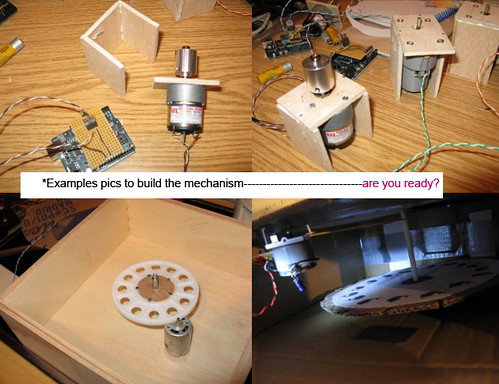
Biophionitos’ stomach is made with Arduino, picture copyright 2008 by the artists
You can go to their website, download the instructions manual, download the application, watch the video (see below) print at your own printer, and build you own visual toy out of cardboard, a motor, and one Arduino board in a matter of minutes … it only depends in how skilled you are in cutting cardboard with a big knife.
Biophionitos has been developed at Medialab-Prado (MAD, ES) and will be presented at the Sonar Festival (BCN, ES) during this week.
RESULTS TO LIBELIUM’S DESIGN CONTEST
– June 2nd, 2008
The Spanish company and Arduino distributor Libelium has released the results for their Arduino Hacks Contest. It was announced on our blog some months ago.
Among the winners and finalists you can find: Javier Briz and Valentin Plugaru with their electronic door-lock Arduino Security, Alex Bell and his Weather Forecaster, Kristin O’Field and Che-Wei Wang from ITP who made momo the city navigation device, Rebecca Stern -featured earlier on this blog- with Sensor Squid, Luis Ignacio Diaz del Dedo and Luis Alberto Perez Garcia proving that there is still a lot to talk about within robotics with their R4P, and Brandon Sweeny with Walbot.
This is the winner in the Robotics Category, R4P, video courtesy of the authors
There are videos, as well as PDFs with documentation to each one of this projects at Libelium’s Contest site.
MIKROGALLERIET
– June 2nd, 2008
Big News from the smalles electronic art gallery in the nordic countries (that I’ve visited so far). Jacob Remin, a media artist that have been part of events like electrolobby06 (Ars Electronica), Halfmachine, running the websitecampingsex.org and one of the initiators of the danish 8-bitklubben is also behind mikrogalleriet.
Picture from Koelse.org, courtesy of the authors
The fact is that Jacob was one of my students at K3 during one term as part of an exchange with DTU (Danish Technical University) where he was taking part in the engineering education. Since then he has been using Arduino in many projects and has helped quite a lot to warm up the hardware electronic art scene in Denmark.
Video courtesy of 8bitklubben.dk from their event mikrodisco
At some point he found a small space in Norrebro, Copenhagen and decided to transform it into an art space. One of the most active until today. I guess I will be blogging more about the Danish art scene and its relationship to Arduino and other open source hardware projects (believe me, there is more). Just as reference you should check Lab, and Komponent, two of the historical groups in Copenhagen doing quite a lot of events.
The video within this post shows an Arduino-hacked football stadium LED screen that somehow ended up in the hands of these people … who said Danes didn’t know how to party?
HYBRID PLAYGROUND
– June 1st, 2008
Clara Boj and Diego Diaz run lalalab.org where they display their media-art pieces, from computer vision to physical computing. Their latest work is called Hybrid Playground, transforming a playground into a video game.

All images are copyright 2008 by C. Boj and D. Diaz
This time they are working together with Martin Nadal, yet another artist from Madrid’s scene and known -among other things- for collaborating in many of the electronic art projects from the Medialab Prado in Madrid, Spain.

All images are copyright 2008 by C. Boj and D. Diaz
Hybrid Playground reflects upon the fact that all kids have video games and brings those to a playground, transforming it into a collaborative game. The video document attached shows Diego and Martin attaching sensors here and there. Those Arduino inside boxes contain an accelerometer and RFID readers, as well as other sensors, that will report over XBee to a server running the game engine.
Video copyright 2008 by C. Boj and D. Diaz
The different players carry a bracelet augmented with RFID tags used for identification. The team leader carries a PDA with connectivity to the server. It will report back information about which is the next goal, and the status in achieving it.
The video is 10 minutes long and is only in Spanish, but contains a full report of the experience made by Clara, Martin and Diego. I like when by the end, Clara evaluates the game together with the kids. At some point one of them comments on this game being better than the Wii from Nintendo, because it brings his attention away from the screen. For being 9 years old kid, this is quite an opinion.
This project was co-produced by Intermediae-Matadero, the brand new art space in Madrid, Spain, and mentioned on El Pais, 20080522.



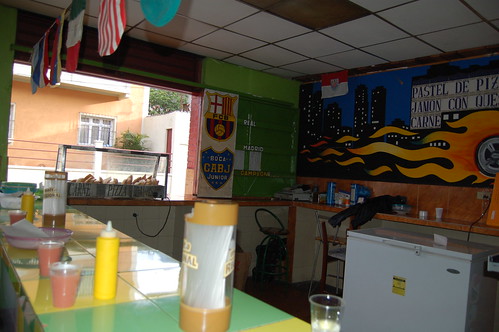
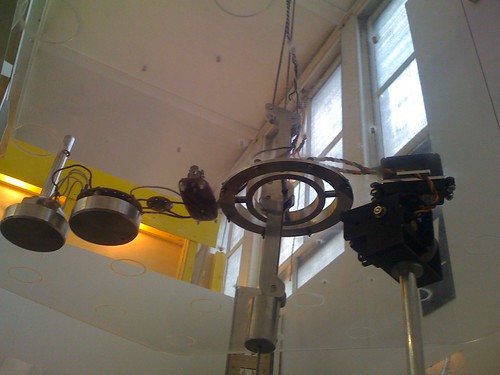
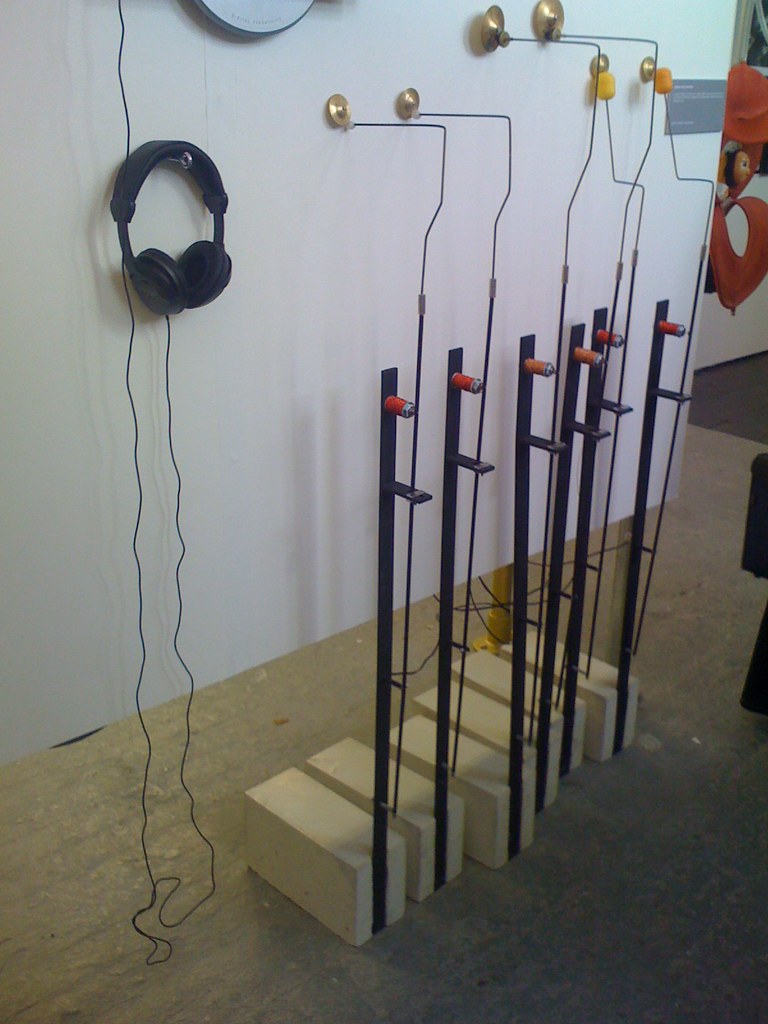
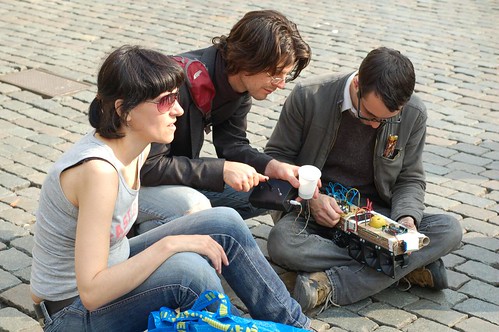







0 comentarios:
Publicar un comentario